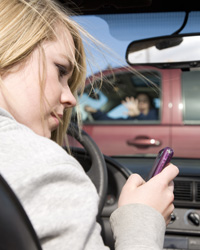| |
Distracted Driving
As April comes to an end, so does the third annual National Distracted Driving Awareness Month, an initiative that aims to educate the public about the dangers of distracted driving. In honor of this effort, Sagamore Insurance Company would like to offer some resources to educate you about the impact this issue can have, as well as methods you can employ in your daily life to minimize your risk of becoming involved in an incident created by distracted driving. We all share the roadways and collectively we can create a safer driving culture for ourselves and the generations that follow. Please take some time to explore this information and pass it along to those closest to you.
The Facts
Distracted driving is any activity that could divert a person's attention away from the primary task of driving. All distractions endanger driver, passenger and bystander safety. These distractions can include texting, using a cell phone, eating, drinking, talking to passengers, grooming, reading, using a navigation system, watching a video, and adjusting a radio, CD player or MP3 player.
Driving is a complex task that requires one's eyes on the road, hands on the wheel and brain focused on the task at hand. According to the National Safety Council, drivers engaged in cell phone conversations, with either hand-held or hands-free devices, can fail to see up to 50 percent of their driving environment, including stop signs, pedestrians and red lights.
Do your part
Pledge to drive distraction-free on the National Safety Council's website. Pledging means you will refrain from having a phone conversation or texting while driving your vehicle.
Spread awareness
In addition to taking the pledge, you can spread awareness of this issue using social media. Share what you know about the dangers of distracted driving on Facebook, Twitter or other sites. Here are some sample tweets you can use:
• |
I care about your safety and I want you to #drivecellfree |
• |
Help save a life. #drivecellfree |
• |
Roadway safety is everyone's responsibility. #drivecellfree
|
Take action
There are several mobile applications that help eliminate or minimize phone usage while driving. Some target teens and families while others are tailored for commercial or fleet operations in an effort to monitor and control for driver behavior. Some popular apps include:
Learn more
For more information on distracted driving, check out the following resources:
|
|
In This Issue
Distracted Driving
Fuel For Thought
|

 Fuel For Thought Fuel For Thought |
|
|
